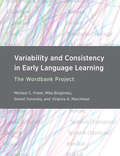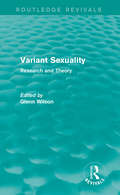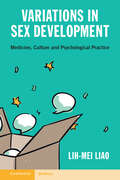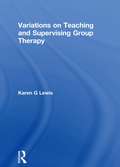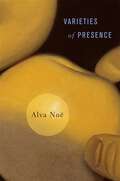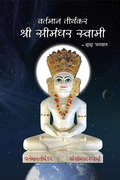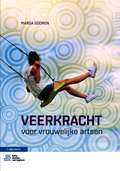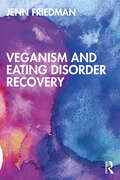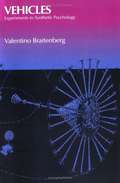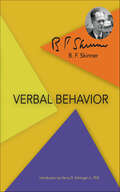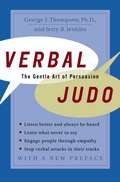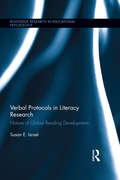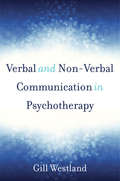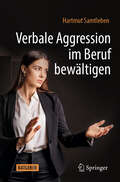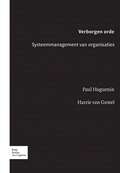- Table View
- List View
Variability and Consistency in Early Language Learning: The Wordbank Project
by Michael C. Frank Mika Braginsky Daniel Yurovsky Virginia A. MarchmanA data-driven exploration of how children's language learning varies across different languages, providing both a theoretical framework and reference.The Wordbank Project examines variability and consistency in children's language learning across different languages and cultures, drawing on Wordbank, an open database with data from more than 75,000 children and twenty-nine languages or dialects. This big data approach makes the book the most comprehensive cross-linguistic analysis to date of early language learning. Moreover, its data-driven picture of which aspects of language learning are consistent across languages suggests constraints on the nature of children's language learning mechanisms. The book provides both a theoretical framework for scholars of language learning, language, and human cognition, and a resource for future research.
Variant Sexuality: Research and Theory (Routledge Revivals)
by Glenn WilsonFirst published in 1987, this book presents contributions from international authorities reviewing major themes in variant sexuality. Genetic and evolutionary arguments are presented for the preponderance of paraphilia in males, whilst Freudian and psychoanalytic theories are shown to have limited scientific basis. These and other topics are reviewed in an interesting book, which will be of particular value to students of the psychology of sexuality, evolutionary biology and psychiatry, as well as those with a more general interest in the social, behavioural and biological aspects of sexuality.
Variations in Sex Development: Medicine, Culture and Psychological Practice
by Lih-Mei LiaoBiological variations in sex development, also known as intersex, are greatly misunderstood by the wider public. This unique book discusses psychological practice in healthcare for people and families impacted by a range of 'intersex' variations. It highlights the dilemmas facing individuals and their loved ones in the social context and discusses the physical and psychological complexities of irrevocable medical interventions to approximate social norms for bodily appearance and function. It exposes the contradictions in medical management and suggests valuable theoretical and practice tools for psychosocial care providers to navigate them. Uniquely featuring theory and research informed practice vignettes, the book explores interpersonal work on the most salient psychosocial themes, ranging from grief work with impacted caretakers to sex therapy with impacted adults. An indispensable resource for working ethically, pragmatically and creatively for a variety of healthcare specialists and those affected by variations in sex development and their families and communities.
Variations on Teaching and Supervising Group Therapy
by Karen Gail LewisLearn effective techniques for teaching and supervising group therapy. This unique new volume brings together teaching and supervisory models for a host of theoretical orientations, including psychodynamic, family systems, psychodrama, gestalt, and transactional analysis. Variations on Teaching and Supervising Group Therapy is essential reading for mental health professionals who currently conduct groups but who lack the specialized training for becoming a supervisor who currently teach group therapy from one theoretical orientation and want to learn about other modalities who teach academic courses on group therapy and want to expose students to a broader perspective of group modalities than the usual one or two models--psychoanalytic and activity groups--usually taught in schoolsThe contributing authors are social workers and professionals from other disciplines who represent a cross section of the teachers of the various types of groups being conducted in the United States today. They describe an exciting array of teaching formats--one-day workshops, semester-long courses, year-long training programs, weekly supervision sessions, and outside consultation--and settings, including family service agencies, child guidance centers, short-term health maintenance organizations, freestanding group training institutions, and private practice.Some of the highlights of this practical book include an examination of the most commonly used format in group therapy today--psychodynamics a demonstration of using family systems theory to understand the group therapy participants and process the key concepts and history of psychodrama the key concepts and basic aspects of a gestalt training program for practicing therapists strategies for teaching social work students a look at the skills needed for conducting group therapy with children a model for training therapists who conduct short-term groups
Varieties of Hope: Stories of Sexuality, Shame and Power
by Jan CampbellThis book explores how hope operates as an ambivalent force in relation to issues of sex and gender, power, and identity in both our private and public lives.The author blends her deep knowledge of psychotherapy and mental health with cultural and philosophical understanding to consider how we have reached our current dilemmas around sex and gender, race, power and identity. Psychoanalysis is put to task in relation to clinical practice, literature, feminism, politics and the understandings of how our personal lives and selves interact with the wider cultural moment we are living through. She explores these issues with compassion and understanding and offers a vision of how we may be able to navigate through widely varying perspectives to a new way of envisioning hope today, as both a false promise and a real and necessary component in our lives and within the clinical encounter.Drawing on clinical psychoanalytic work as well as literature and memoir, this is essential reading for anyone wanting a psychoanalytically informed understanding of where society is on key issues and where we may be able to get to with hope.
Varieties of Memory and Consciousness: Essays in Honour of Endel Tulving
by Henry L. Roediger Fergus I.M. CraikThese collected essays from leading figures in cognitive psychology represent the latest research and thinking in the field. The volume is organized around four "Endelian" themes: encoding and retrieval processes in memory; the neuropsychology of memory; classificatory systems for memory; and consciousness, emotion, and memory.
Varieties of Presence
by Alva NoeThe world shows up for us-it is present in our thought and perception. But, as Alva NoË contends in his latest exploration of the problem of consciousness, it doesn’t show up for free. The world is not simply availab≤ it is achieved rather than given. As with a painting in a gallery, the world has no meaning-no presence to be experienced-apart from our able engagement with it. We must show up, too, and bring along what knowledge and skills we’ve cultivated. This means that education, skills acquisition, and technology can expand the world’s availability to us and transform our consciousness. Although deeply philosophical, Varieties of Presence is nurtured by collaboration with scientists and artists. Cognitive science, dance, and performance art as well as Kant and Wittgenstein inform this literary and personal work of scholarship intended no less for artists and art theorists, psychologists, cognitive scientists, and anthropologists than for philosophers. NoË rejects the traditional representational theory of mind and its companion internalism, dismissing outright the notion that conceptual knowledge is radically distinct from other forms of practical ability or know-how. For him, perceptual presence and thought presence are species of the same genus. Both are varieties of exploration through which we achieve contact with the world. Forceful reflections on the nature of understanding, as well as substantial examination of the perceptual experience of pictures and what they depict or model are included in this far-ranging discussion.
Vartaman Tirthankar Shree Simandhar Swami: वर्तमान तीर्थकर श्री सीमंधर स्वामी
by Dada Bhagwanइस काल में इस क्षेत्र से सीधे मोक्ष पाना संभव नहीं है, ऐसा शास्त्रों में कहा गया हैं। लेकिन लंबे अरसे से, महाविदेह क्षेत्र में श्री सीमंधर स्वामी के दर्शन से मोक्ष प्राप्ति का मार्ग खुला ही हैं। लेकिन परम पूज्य दादाश्री उसी मार्ग से मुमुक्षुओं को मोक्ष पहुँचानें में निमित्त हैं और इसकी प्राप्ति का विश्वास, मुमुक्षुओं को निश्चय से होता ही है। इस काल में, इस क्षेत्र में वर्तमान तीर्थंकर नहीं हैं। लेकिन महाविदेह क्षेत्र में वर्तमान तीर्थंकर श्री सीमंधर स्वामी विराजमान हैं। वे भरत क्षेत्र के मोक्षार्थी जीवों के लिए मोक्ष के परम निमित्त हैं। ज्ञानीपुरुष ने खुद उस मार्ग से प्राप्ति की और औरों को वह मार्ग दिखाया है। प्रत्यक्ष प्रकट तीर्थंकर की पहचान होना, उनके प्रति भक्ति जगाना और दिन-रात उनका अनुसंधान करके, अंत में, उनके प्रत्यक्ष दर्शन पाकर, केवलज्ञान को प्राप्त करना, यही मोक्ष की प्रथम और अंतिम पगडंडी है। ऐसा ज्ञानियों ने कहा हैं। श्री सीमंधर स्वामी की आराधना, जितनी ज़्यादा से ज़्यादा होगी, उतना उनके साथ अनुसंधान विशेष रहेगा। इससे उनके प्रति ऋणानुबंध प्रगाढ़ होगा। अंत में परम अवगाढ़ दशा तक पहुँचकर उनके चरणकमलों में ही स्थान प्राप्ति की मोहर लगती है।
Veerkracht voor vrouwelijke artsen
by Marga GoorenArtsen houden van hun vak. Het geeft veel voldoening om contact te hebben met mensenen een verschil te kunnen maken.Het is ook een moeilijk vak. Veel artsen worstelen. De werkdruk wordt steeds hoger. De eisen van overheid en verzekeraars en ook patiënten nemen toe. In combinatie met een zorgzame, hardwerkende en perfectionistische houding van de dokter leidt dit tot stress en soms zelfs burnout.Vrouwelijke artsen treft dit vaak nog wat harder, omdat zij over het algemeen meer enbeter voor anderen zorgen dan voor zichzelf.Hoe blijf je als vrouwelijke arts overeind? Hoe zorg je dat je stevig in je schoenen staat enmakkelijk terugveert in lastige situaties? Hoe houd je plezier in je werk en ben je de bestedokter die je kunt zijn? Hoe zorg je goed voor jezelf terwijl je voor anderen zorgt? Kortom;hoe ontwikkel je veerkracht?
Veganism and Eating Disorder Recovery
by Jenn FriedmanThis book addresses the eating disorder field’s misconceptions about veganism with the goal of realigning the discourse about veganism and non-veganism in eating disorder recovery. Veganism and eating disorders are often associated with one another in the eating disorder field, leading to the widely adopted belief that following the dietary component of veganism may inhibit recovery from an eating disorder. Friedman posits that this belief is founded on an oversimplified view and counters it by exploring the ethical dimensions of veganism. In this book, Friedman looks at ideas perpetuated around veganism and recovery, including the potential harm to vegans prohibited from following veganism in treatment centers. Veganism and Eating Disorder Recovery culminates in a prospective proposal for a "vegan-informed" eating disorder recovery model, which may be adapted for clients’ individual needs. Friedman lays a foundation for an improved discourse on veganism and eating disorders by drawing from a wide range of resources, including academic research, blog posts, eating disorder literature, and anecdotes. This accessible text will appeal to professionals and eating disorder clients alike, enabling them to collaborate under optimal conditions.
Vehicles: Experiments in Synthetic Psychology
by Valentino BraitenbergEach of the vehicles in the series incorporates the essential features of all the earlier models and along the way they come to embody aggression, love, logic, manifestations of foresight, concept formation, creative thinking, personality, and free will.
Vence A Tus Pensamientos o Ellos Te Vencerán A Ti: Aprende a educar tu mente
by Danilo H. GomesHace muchos años, grandes científicos preveían que, en un futuro muy próximo, la depresión sería uno de los mayores males que asolaría la humanidad. Ellos acertaron. Vivimos en un mundo caótico en el que es cada vez más raro encontrar la paz. La agitación de lo cotidiano transforma mentes quietas en espacios llenos de ruido. ¿Tu mente se encuentra en este estado? Es hora de hacer algo. En este libro, de una forma bien explicada, encontrarás buenas reflexiones y formas de vencer las voces que permean el campo de nuestras mentes. Educa tu mente con la ayuda de este libro y aprende a dar la debida atención a las voces que realmente merecen nuestra atención.
Venedig ist überall: Vom Übertourismus zum Neuen Original
by Bruno S. FreyKultureller Übertourismus ist das neue Schlagwort für von Touristen extrem stark frequentierte und damit überfüllte historische Sehenswürdigkeiten, Museen und Städte. Ein Kulturtourismus also, der negative Auswirkungen sowohl für die kulturellen Orte als auch für die dort lebenden Menschen zeitigt. In Reaktion darauf wird vermehrt protestiert und Kulturträger und Bürgermeister ergreifen zunehmend Maßnahmen, um den Touristenstrom zu begrenzen. Ist dies das Ende einer „Kultur für alle“?In diesem Buch schlägt Bruno S. Frey - renommierter und vielzitierter Kulturökonom - im Gegenteil eine Erweiterung des Angebotes als „Neue Originale“ vor: Die wichtigsten Monumente werden an einem geografisch geeigneten Ort identisch kopiert. Ergänzend werden den Besuchern mithilfe digitaler Informationstechnologien (Augmented und Virtual Reality inklusive Hologramme) Geschichte und Kultur der Orte nahe gebracht. Angrenzende Hotels, Restaurants und Läden bieten die notwendige begleitende Infrastruktur. Auf diese Weise kann der Touristenstrom zwischen den ursprünglichen und den „Neuen Originalen“ verteilt werden. Diese Idee wird mit seinen organisatorischen und ökonomischen Herausforderungen skizziert und von bestehenden Disneyland-Konzepten abgegrenzt. Gerade für Familien mit Kindern und allgemein kulturell interessierte Personen – also für die größte Zahl der Besucher – können diese „Neuen Originale“ sehr attraktiv sein.
Verantwortung wahrnehmen als Verantwortung aus Leidenschaft (essentials)
by Philipp StoellgerIst Verantwortung als Pflicht zu verstehen – oder auch als Leidenschaft, als Passion für den Nächsten? Der hier gewagte Versuch plädiert für solch ein leidenschaftliches Verständnis von Verantwortung. Denn der Ruf nach Verantwortung kommt immer schon zu spät: wenn sie nicht wahrgenommen wurde. Wo aber entsteht sie und warum sollte man Verantwortung übernehmen? Aus zwingenden Gründen oder traditionellen Verpflichtungen? Will man heute Verantwortung neu wahrnehmen, lohnt sich der Versuch, sie neu zu verstehen: Verantwortung als etwas Fragiles und Vulnerables; als eine unausweichliche und unwillkürliche Antwort auf den Anspruch des Anderen – als eine Leidenschaft für den Nächsten.
Verbal Behavior
by B. F. SkinnerOver half a century after its initial publication in 1957, Verbal Behavior has remained in high demand and continues to contribute to science and society. The documented efficacy of Skinner's practices has maintained the popularity of Verbal Behavior despite the initial criticism from Noam Chomsky's allegedly fatal review. In fact, his research has inspired techniques that have proven increasingly successful with aberrant behavior disorders, such as autism and delayed speech. In this brilliant and ambitious work, Skinner gives a functional analysis of verbal behavior and argues that operant conditioning can account for and explain a large portion of linguistic phenomena, as demonstrated in laboratory experiments and extensive literary analysis. Skinner details the consequences and issues of this analysis and addresses its philosophical implications, such as the social aspects of language and natures of meaning and thought. Skinner's classic study of psychology, while controversial, has contributed to the welfare of society, and it continues to inspire a growing body of research and applications. Verbal Behavior is an exceptional theoretical work for those who wish to understand the principals of behavioral therapy.
Verbal Behavior: Extended Edition
by B. F. SkinnerVerbal Behavior is a 1957 book by psychologist B. F. Skinner, in which he describes what he calls verbal behavior, or what was traditionally called linguistics. Skinner's work describes the controlling elements of verbal behavior with terminology invented for the analysis—echoics, mands, tacts, autoclitics and others—as well as carefully defined uses of ordinary terms such as audience.
Verbal Judo
by George ThompsonImprove communication, resolve conflicts, and avoid the most common conversational disasters through simple, easily remembered strategies that deflect and redirect negative behaviour. Verbal Judo is the martial art of the mind and mouth that can show you how to be better prepared in every verbal encounter. Listen and speak more effectively, engage people through empathy (the most powerful word in the English language), avoid the most common conversational disasters, and use proven strategies that allow you to successfully communicate your point of view and take the upper hand in most disputes.
Verbal Judo, Second Edition: The Gentle Art of Persuasion (Police Science Ser.)
by George J. Thompson"When you react, the event controls you. When you respond, you're in control."Verbal Judo is the classic guide to the martial art of the mind and mouth that can help you defuse confrontations and generate cooperation, whether you're talking to a boss, a spouse, or even a teenager. For more than a generation, Dr. George J. Thompson's essential handbook has taught people how to communicate more confidently and persuasively in any situation. Verbal Judo shows you how to listen and speak more effectively, engage others through empathy (the most powerful word in the English language), avoid the most common conversational disasters, and use proven strategies to successfully express your point of view--and take the lead in most disputes.This updated edition includes a new foreword and a chapter featuring Dr. Thompson's five universal truths of "human interaction": People feel the need to be respected People would rather be asked than be told People have a desire to know why People prefer to have options over threats People want to have a second chanceStop being frustrated and misunderstood. Stop finding yourself on the losing end of an argument. With Verbal Judo you'll be able to have your say--and say what you mean.
Verbal Protocols in Literacy Research: Nature of Global Reading Development (Routledge Research in Educational Psychology #3)
by Susan E. IsraelThis volume offers an updated analysis of the methodology of reading and reading research since 1995, when the landmark book Verbal Protocols of Reading: The Nature of Constructively Responsive Reading by Michael Pressley and Peter Afflerbach was published. It offers a thorough cross-analysis of the conscious processes experienced during reading, the structure of reading comprehension, and its application to more current initiatives such as Common Core State Standards and Response to Intervention. It also provides a detailed analysis of Constructively Responsive Reading through relevant online self-report studies in reading and reading comprehension behavior. It is a fresh and comprehensive volume that speaks not only to reading researchers, but to literacy teachers at all levels.
Verbal and Non-Verbal Communication in Psychotherapy
by Gill WestlandImplicit communications analyzed alongside verbal communication in therapy. Body language, facial expression, and tone of voice are key components in therapeutic interactions, but for far too long psychotherapists have dismissed them in favor of purely verbal information. In Verbal and Non-Verbal Communication in Psychotherapy, Gill Westland examines the interrelation of the verbal and the non-verbal in the context of clients and therapists working together. The physiology of communication is also discussed: from overwhelming emotions that make it difficult to speak to breath awareness that makes it easier. Therapists will be able to cultivate non-verbal communication through mindfulness practices and "right brain to right brain communication." It is not just the client's actions and emotions that are significant; it is important that therapists relate in a way that makes it clear to their clients that they are receptive and inviting, and Westland expertly depicts the bodily dimensions of this encounter between client and therapist. The book brings together insights from a range of psychotherapeutic traditions, including psychoanalysis, arts psychotherapies, humanistic psychotherapy, and, in particular, body psychotherapy, for clinicians who want to expand their communication abilities. Drawing on 30 years of clinical experience, and providing illustrative clinical vignettes, Westland has written a guide both for those who might not have any experience in the theory of non-verbal communications and for lifelong psychotherapy practitioners. She lays as groundwork recent research into the neurobiology of interaction and the foundations of non-verbal communication in babyhood, continuing throughout from a bodymind perspective that pays due attention to the physicality of the body. Westland urges therapists to learn how to leave their comfort zone and try new ways of helping their clients. Writing in a richly evocative, lucid language, Westland seeks to bring about change in both psychotherapist and client as they navigate both the verbal and non-verbal aspects of embodied relating.
Verbale Aggression im Beruf bewältigen
by Hartmut SamtlebenDieser Ratgeber ermutigt und befähigt Menschen, auf eine verbale Attacke souverän zu reagieren und mit einer strukturierten Methode eine Konfrontation in Kollaboration zu verwandeln – realistisch, wirksam und direkt umsetzbar. Verbale Aggression tritt durch die hohe Dynamik im Beruf immer häufiger auf. Jeder ist davon betroffen, und die wenigsten können konstruktiv darauf reagieren. Das Buch vermittelt mit einer Fülle an Beispielen, welche Formen die oft verschleierte verbale Aggression annimmt und welche physiologischen Reaktionen und psychologischen Abläufe eine Rolle spielen. Es liefert konkrete Techniken, um sich zu fangen und ein Gespräch zu kontrollieren, und bietet ein strukturiertes Vorgehen, um einen Angriff zu begrenzen und in ein konstruktives Miteinander umzuwandeln. Dazu gibt es eine konkrete Anleitung, um diese Kompetenz zu vertiefen. So gewinnen Sie Souveränität und Sicherheit, um verbale Aggression im Beruf zu bewältigen und zu einem positiven Ergebnis zu führen. Die Zielgruppen Alle berufstätigen Menschen, insbesondere Führungskräfte, HR-Mitarbeiter, Moderatoren und Coaches.
Verborgen orde
by P. Huguenin H. W. GestelHet komt vaak voor dat organisaties immuun zijn voor pogingen tot verandering. Verborgen orde zet uiteen wat er voor nodig is om meer succes te hebben bij het realiseren van veranderingen in een organisatie. Op heldere en humoristische wijze wordt met herkenbare voorbeelden inzicht gegeven in de (systeem)eigenschappen van organisaties die bepalend zijn voor het effect van veranderinterventies. In het boek wordt ingegaan op 'patronen' van werken en hoe die, wanneer men wil veranderen, doorbroken kunnen worden. De lezer krijgt vernieuwende handreikingen voor succesvol interveniëren: systeembewust leiderschap, kaderen en domeinsturing. Praktijkgerichte inhoudelijke hoofdstukken worden afgewisseld met een verhaal waarin vijf mensen op zoek gaan naar hoe zij veranderingen in hun uiteenlopende organisaties kunnen realiseren. Op deze manier slagen de auteurs erin om de systeemtheorie toegankelijk te maken voor een brede groep mensen.
Verdad: Cómo los distintos lados de cada historia configuran nuestra realidad
by Hector Macdonald¿Verdad o mentira? Las cosas casi nunca son tan sencillas.Un alegato a favor de la verdad en tiempos de posverdad. Hay más de una verdad acerca de casi todo. Comer carne es nutritivo, pero también perjudicial para el medioambiente. Internet difunde el conocimiento, pero también el odio. Como es lógico, cuando nos comunicamos seleccionamos aquellas verdades que son más favorables a lo que nos interesa defender. Podemos elegir verdades de manera constructiva para inspirar a nuestros compañeros, animar a las nuevas generaciones y fomentar cambios positivos. O podemos optar por aquellas que proyectan una imagen falsa de la realidad y engañan a la gente sin mentir. Los demás pueden hacer lo mismo, motivarnos o manipularnos mediante la verdad. Las verdades son herramientas neutrales y muy versátiles que podemos emplear para bien o para mal. En Verdad, Hector Macdonald explora cómo se usa y abusa de la verdad en la política, los negocios, los medios de comunicación y la vida cotidiana, para demostrar que una mejor comprensión de las muchas caras de la verdad nos ayuda a navegar mejor nuestro mundo e influir más en él. Macdonald combina su talento narrativo con lecciones prácticas y una sucesión de historias fascinantes, divertidas e iluminadoras. Verdad es un libro necesario y adictivo acerca de cuán profundamente nuestras acciones y opiniones se ven influidas por las verdades que deciden contar quienes nos rodean
Vergeben in Beratung und Therapie: Eine praxisnahe Einführung (essentials)
by Agostino Mazziotta Jonas ReinhardtIn zwischenmenschlichen Beziehungen ist es nahezu unausweichlich, dass Menschen sich gegenseitig verletzen. In manchen Fällen gelingt es den Betroffenen jedoch nicht, diese Verletzungen zu verarbeiten, Rachefantasien und negative Gefühle auf den Verursacher ruhen zu lassen. Vergebung ist eine Möglichkeit, eigene Verletzungen zu bewältigen. Ärger, Hass oder Verbitterung werden dabei losgelassen, um eine freundlichere und mitfühlendere Haltung gegenüber einer verletzenden Person zu entwickeln. Diese veränderte Haltung kommt der vergebenden Person zugute, da sie etwa das Wohlbefinden und die Gesundheit verbessern kann. Im Rahmen einer Beratung oder Therapie können Menschen, die vergeben wollen, auf ihrem Weg unterstützt werden. Dieses Essential bietet eine wissenschaftlich fundierte Einführung in interpersonelle Vergebung und eine praxisnahe Anleitung für die beraterisch-therapeutische Begleitung von Vergebungsprozessen.
Verhalten bei Gewalt – Selbstschutz für Erwachsene: Dein persönliches Konzept für Gewaltprävention und Selbstverteidigung
by Swen Körner Mario S. StallerDieses Buch haben wir für all jene geschrieben, die sich im Umgang mit – auch körperlichen – Konflikten vorbereiten wollen, um sich noch sicherer zu fühlen. Vielleicht hast du ja selbst schon einmal Gewalt erlebt und bist in eine brenzlige Konfliktsituation geraten: Jemand hat dich im Supermarkt doof angemacht, als Fußgänger missachtet, auf einer Feier beleidigt, dir Prügel angedroht. Im Nachgang hast du dich vielleicht gefragt, wie du besser hättest reagieren können.In sechs Etappen und anhand konkreter Beispiele führen wir dich zu einem kompetenteren Umgang mit Gewaltsituationen: von der Einschätzung einer Konflikt- und Gewaltsituation über Gewaltprävention bis hin zu einfachen Selbstverteidigungs-Optionen. Wir haben versucht, das Buch leicht lesbar und anschaulich zu schreiben. Innerhalb einzelner Kapitel schildern wir Konflikt- und Gewaltsituationen. An diesen Situationen machen wir fest, was du tun kannst, um Konflikte zu vermeiden und dich und andere vor Gewalt zu schützen. Zum Schluss zeigen wir in bebilderten Darstellungen einige Tricks und Techniken zum Selbstschutz. Schließlich fassen wir jedes Kapitel mit Empfehlungen für dich zusammen. Aus dem InhaltIn 6 Etappen zum kompetenten Umgang mit Gewaltsituationen – mit Tipps zum Üben46 Werkzeuge zu Gewaltprävention, Selbstschutz und Selbstverteidigung – von Abstand halten bis HammerfaustReale Situationen: in der S-Bahn, an der Supermarktkasse, auf dem Parkplatz, nachts nach dem Clubbesuch, häusliche Gewalt
